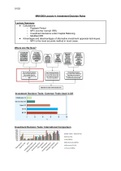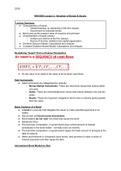Suprajasaravanan
On this page, you find all documents, package deals, and flashcards offered by seller suprajasaravanan.
- 10
- 0
- 1
Community
- Followers
- Following
11 items

Lecture 9: Dividends & Payout Policy
Lecture Summary: Assessing Your Firm's Payout Policy ● Compare your firm’s dividends to its FCFE, looking at the last 5 years of information. ● Based upon your earlier analysis of your firm’s project choices, would you encourage the firm to return more cash or less cash to its owners? ● If you would encourage it to return more cash, what form should it take (dividends versus stock buybacks)? ● Customize a solution for your firm’s dividend policy, but think about your earlier...
- Lecture notes
- • 12 pages •
Lecture Summary: Assessing Your Firm's Payout Policy ● Compare your firm’s dividends to its FCFE, looking at the last 5 years of information. ● Based upon your earlier analysis of your firm’s project choices, would you encourage the firm to return more cash or less cash to its owners? ● If you would encourage it to return more cash, what form should it take (dividends versus stock buybacks)? ● Customize a solution for your firm’s dividend policy, but think about your earlier...

ES30027 Econometrics 1 Egg Timer
Here's a neat little summary sheet(s) of all the concepts covered in the ES30027 module, namely Econometrics concepts with Matrix Algebra. Key topics include: Matrix Algebra Review, Probability Distributions, Hypothesis Testing, Heteroskedasticity, Instrumental Variables & Maximum Likelihood Estimation. Covers all the key concepts you need to remember at the last moment, great to review right before your exam!
- Summary
- • 15 pages •
Here's a neat little summary sheet(s) of all the concepts covered in the ES30027 module, namely Econometrics concepts with Matrix Algebra. Key topics include: Matrix Algebra Review, Probability Distributions, Hypothesis Testing, Heteroskedasticity, Instrumental Variables & Maximum Likelihood Estimation. Covers all the key concepts you need to remember at the last moment, great to review right before your exam!

MN10500 Lecture Notes Bundle
Here's a bundle of all my lecture notes from the module MN10500: Corporate Finance for Managers. A great comprehensive source of key concepts related to Corporate Finance, I used these a lot in my second and third year as well!
- Package deal
- • 8 items •
- Lecture 1: Basics of Corporations • Lecture notes
- Lecture 2: The Time Value of Money • Lecture notes
- Lecture 3: Valuation of Bonds & Stocks • Lecture notes
- Lecture 4: Investment Decision Rules • Lecture notes
- Lecture 5: Introduction to Risk & Return • Lecture notes
- And more ….
Here's a bundle of all my lecture notes from the module MN10500: Corporate Finance for Managers. A great comprehensive source of key concepts related to Corporate Finance, I used these a lot in my second and third year as well!

Lecture 8: Debt Policy & Optimal Capital Structure
Lecture Summary ● The trade-off between debt and equity. ○ Benefits ○ Costs ● Alternative capital structure theories and empirical evidence. ● The (simplified) cost of capital model to determine the optimal debt-equity combination that minimises WACC.
- Package deal
- Lecture notes
- • 13 pages •
Lecture Summary ● The trade-off between debt and equity. ○ Benefits ○ Costs ● Alternative capital structure theories and empirical evidence. ● The (simplified) cost of capital model to determine the optimal debt-equity combination that minimises WACC.

Lecture 7: Corporate Financing & Capital Structure
Corporate Financing Patterns ● Internally generated funds: ○ Retained earnings/plowback profit ● External sources of finance: ○ Debt ○ Equity ● Firms may raise funds from external sources or plow back profits (internal funds). External financing involves the choice between debt & equity. ● In practice, there are securities lying between the spectrum of 'pure' debt & equity and they are sometimes called 'mezzanine' or 'hybrid' securities.
- Package deal
- Lecture notes
- • 9 pages •
Corporate Financing Patterns ● Internally generated funds: ○ Retained earnings/plowback profit ● External sources of finance: ○ Debt ○ Equity ● Firms may raise funds from external sources or plow back profits (internal funds). External financing involves the choice between debt & equity. ● In practice, there are securities lying between the spectrum of 'pure' debt & equity and they are sometimes called 'mezzanine' or 'hybrid' securities.

Lecture 6: The Cost of Capital
Lecture Summary ● Market risk is the only relevant risk in a diversified portfolio. ● Capital Asset Pricing Model (CAPM) ○ Calculations ○ Critiques: Its assumptions & arguments/evidence against them. ● Cost of Capital (WACC) ○ Always after-tax, unless otherwise indicated.
- Package deal
- Lecture notes
- • 7 pages •
Lecture Summary ● Market risk is the only relevant risk in a diversified portfolio. ● Capital Asset Pricing Model (CAPM) ○ Calculations ○ Critiques: Its assumptions & arguments/evidence against them. ● Cost of Capital (WACC) ○ Always after-tax, unless otherwise indicated.

Lecture 5: Introduction to Risk & Return
Lecture Summary ● Common measures of risk and return ○ Compare different asset classes ● Portfolio risk and return ○ Return as weighted-average return ○ Risk (in most cases) not weighted-average, but dependent on correlation. ● Diversification ○ Market (systematic) and unique (firm-specific) risks.
- Package deal
- Lecture notes
- • 7 pages •
Lecture Summary ● Common measures of risk and return ○ Compare different asset classes ● Portfolio risk and return ○ Return as weighted-average return ○ Risk (in most cases) not weighted-average, but dependent on correlation. ● Diversification ○ Market (systematic) and unique (firm-specific) risks.

Lecture 4: Investment Decision Rules
Lecture Summary ● Calculations: ○ Payback Period ○ NPV (not the 'normal' IRR) ○ Investment decisions under Capital Rationing ○ Modified IRR ● Advantages and disadvantages of alternative investment appraisal techniques: ○ NPV is the most accurate method in most cases.
- Package deal
- Lecture notes
- • 7 pages •
Lecture Summary ● Calculations: ○ Payback Period ○ NPV (not the 'normal' IRR) ○ Investment decisions under Capital Rationing ○ Modified IRR ● Advantages and disadvantages of alternative investment appraisal techniques: ○ NPV is the most accurate method in most cases.

Lecture 3: Valuation of Bonds & Stocks
Lecture Summary ● Characteristics of bonds ● Bond price as the present value of coupons and principal ● Characteristics of equity (stock) ● Dividend Discount Model: Calculations and critiques ● Constant Dividend Growth Model: Calculations and critiques
- Package deal
- Lecture notes
- • 9 pages •
Lecture Summary ● Characteristics of bonds ● Bond price as the present value of coupons and principal ● Characteristics of equity (stock) ● Dividend Discount Model: Calculations and critiques ● Constant Dividend Growth Model: Calculations and critiques

Lecture 2: The Time Value of Money
Notes taken from the lecture on The Time Value of Money. A more detailed guide on the basics of present value and future value of money, and related concepts.
- Package deal
- Lecture notes
- • 6 pages •
Notes taken from the lecture on The Time Value of Money. A more detailed guide on the basics of present value and future value of money, and related concepts.
